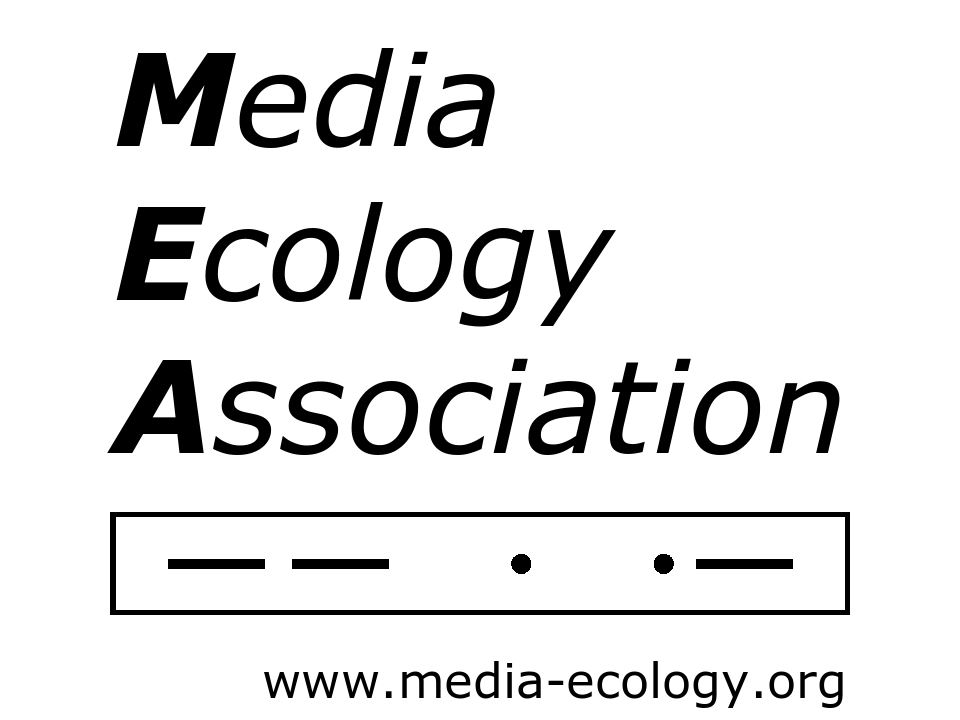MEA @ NCA 2022

The Media Ecology is pleased to sponsor the following sessions at this year’s National Communication Association Convention, November 17–20, 2022 in New Orleans, LA.
Thursday, Nov. 17
The Moral Force of Place: Habitats for Communication
12:30–1:45 PM CST, Napoleon Ballroom D1 - 3rd Floor, Sheraton
These papers consider what happens when the lack of anchored space goes beyond fraying the edges of higher learning, democracy, and citizenship to actually tearing it apart. They ask, does the artificial environment in which we increasingly live do anything to help human flourishing?
The Covid Epidemic was a disrupting force which came at what was already a transitional time for American life. When the world quickly pivoted to move essential functions to on-line formats, many observers prophesized the end of classroom learning, office working, and other in-person experiences. Instead, it may have created a generation which has become disillusioned with technological modes of instruction and simulated experience. Through the lens of media ecology, these papers argue that on-line modalities undermine the democratizing denouements of space which teach participants habits of mind and discursive skills that are precursors for cultivating the common good.
When the discursive practices which sustain democracies become dis-placed, they become demonstrably different. When Stephen Carter discusses “the etiquette of democracy,” he defines civility as “the sum of the many sacrifices we are called to make for the sake of living together.” Jacques Ellul contends that those who are not grounded in local, material communities are more susceptible to the propagandist. These studies seek to demonstrate that grounded, placed, material rhetorics produce fidelity and propriety in democratic communities which, when practiced, produce good citizens.
Chair
Stephanie A. Bennett, Palm Beach Atlantic University
Co-Chair
Tom St. Antoine, Palm Beach Atlantic University
Presenter
Joseph Sowers, Palm Beach Atlantic University
Respondent
Lance A. Strate, Fordham University
Friday, Nov. 18
A Roundtable Discussion of Surfing the Anthropocene: Digital Affect and the Big Tension
8:00–9:15 AM CST, Napoleon Ballroom A3 - 3rd Floor, Sheraton
Eric Jenkins’ book Surfing the Anthropocene explores and updates the media ecology metaphor for the digital age, diagramming the digital atmosphere, climate, hydrosphere, and lumisphere in search of why experience on the public screen feels so intense, so anxiety-inducing, so full of both innervating and debilitating sparks of energy. This feeling stems from what Jenkins labels the big tension, the friction between the global and epochal scale of the digital (the Anthropocene) and the typically rapid, skimming, and shifting paces through which users encounter it (surfing). The book argues that people respond to this big tension by adopting immeditative and attentional modes, in contrast to more meditative and tending modes like gardening, in ways that undermine the democratic and progressive potentials of digital media. The notions of immeditative and attentional, as well as the larger contention about the big tension, illustrate how Jenkins centers his analysis on the transformations to spatiality and temporality, following the media ecological insights of such forebears as Harold Innis, Marshall McLuhan, and Lewis Mumford. Jenkins shows how the tensions between the enormous scale and accelerated pace of the digital ecology generates a number of stresses and strains characterizing experience online, especially when it comes to following the news, witnessing events like police shootings, and discussing politics on social media. Chock full of concepts for media ecology scholars, this panel explores Jenkins’ map of this digital ecology and responds to his suggestions for thriving in the digital Anthropocene.
Chair
Valerie V. Peterson, Grand Valley State University
Presenter(s)
Corey Anton, Grand Valley State University
Caitlin Frances Bruce, University of Pittsburgh
Byron B. Craig, Illinois State University
Michael Lechuga, University of New Mexico
Valerie V. Peterson, Grand Valley State University
Respondent
Eric S. Jenkins, University of Cincinnati
Saturday, Nov. 19
Revisiting Talking Tombstones
12:30–1:45 PM CST, Napoleon Ballroom D1 - 3rd Floor, Sheraton
This year marks the thirty-fifth anniversary of the publication of Talking Tombstones & Other Tales of the Media Age by Gary Gumpert. It is remarkable how well this book on technology has held up. Gumpert dealt with everything from the impact of instant replay to private museum tours. Philosophically the book engages multiple philosophical perspectives such as the ideas of particular media ecologists to theories of nostalgia and from aesthetics to authenticity. Many of the topics and issues discussed are very relevant today. As Gumpert said, “Talking Tombstones looks at the artifacts of media technology which emerged out of the inventiveness imagination, and needs of the human being to transcend limitations to communication… The artifacts speak and we listen” (Gumpert, 1987, p 13).
This panel will reflect on what we heard and continue to hear in Talking Tombstones. The presenters range from graduate students to emeritus professors who will come together to reflect on the “monument” of Talking Tombstones thirty-five years later. The panelists are asked to reflect on the questions: What impact did Talking Tombstones have on the field of communication? What part (or parts) of the book resonate the most with you? How do you think the book holds up today? Are there technological or other media advances that should be updated in the book?
Chair
Erik Garrett, Duquesne University
Presenter(s)
Erik Garrett, Duquesne University
Thomas F. Gencarelli, Manhattan College
Abbey Nicole McCann, Duquesne University
Peter L. Haratonik
Jessica Neu, Duquesne University
Michael Plugh, Manhattan College
Susan Drucker, Hofstra University
Lance A. Strate, Fordham University
Respondent
Gary Gumpert, Urban Communication Foundation
Humanity’s Place, Play, and Replay: Where Does Media Evolution Lead Us?
2:00–3:15 PM CST, Napoleon Ballroom A2 - 3rd Floor, Sheraton
New media replace old ones with increasing frequency. The change of dominant media used to take centuries; now it happens in a decade. The accelerating emergence of new media seems to follow a certain logic, which can be identified as the logic of media evolution. Evolution might not have a purpose, but the logic or moving forces of media evolution certainly shape the media environment.
It is becoming clearer that media are the socio-forming and terraforming force. The acceleration of media development affects the social order and causes the cultural turbulences of a civilization scale. That is why an understanding of media evolutionary logic is crucially important for coping with the tectonic media effects today and predicting tomorrow’s development of media.
The logic of media evolution does not come down to the linear succession of technologies. The inquiry into the logic of media evolution is bigger and, most importantly, more complex than just media history or media archeology. As evolution is a fundamental concept of ecology, so media evolution can be seen as a central concept within media ecology. Media evolution ties not just media ecology to the past development of media; most importantly, media evolution addresses the future of media and – of humankind and the planet.
The core question of the enquiry into media evolution is simple: Where does media evolution lead us? The media evolutionary approach in media ecology can offer an apparatus to explore and, hopefully, secure our future.
Since it is becoming clearer that media are the agent of changes and hence the shaper of the future, the demand for evolutionary media ecology will only grow. The works of Innis, McLuhan, and Postman were inherently evolutionary. With these figures on the ground in mind, the panel will focus on exploration of the logic of media evolution. The starting point for the discussion is Paul Levinson’s 2017 (1978) book Human Replay: A Theory of the Evolution of Media. Being a pioneer in developing an evolutionary concept of media ecology, Levinson introduced the “anthropotropic” model of media evolution. The anthropotropic theory holds that media evolve to better accommodate human needs in interactions with the environment. Mediating the environment, technologies must be compatible with human operational abilities. They must “replicate” the natural or “pre-technological” mode of sensorial and mental operations, hence the term “anthropotropic” – “moving towards human”. At the same time, media need to extend natural human capacities “to overcome the biological constrictions… the limitations of space and time that are a part of pre-technological environments” (pp. 23 - 24). Aligning with natural human capacities, media simultaneously extend those capacities across space and time. Therefore, media that survive and succeed replicate the pre-technological world better while extending humans across space and time.
Levinson’s 1978 anthropotropic model of media evolution has been revised by Andrey Mir in his 2022 paper “Media evolution – the evolution of what?” (accepted by ETC, expected to published — Summer 2022). Mir argues that media evolution seen by Levinson as the evolution of media as species must lead to a paradox. If media replicate the human mode of interactions with reality (Levinson’s “human replay”), then they must evolve, if they succeed, into the Ultimate Medium, the main feature of which will be… the total elimination of mediation. The best possible Ultimate Medium must not mediate. It must induce reality and immerse the user into it. It will stop being a medium and become an environment.
A species cannot “purposedly” evolve towards its extermination. Therefore, media evolution is not the evolution of media as species but evolution of something else. The final, Ultimate Medium must be so perfectly good at “human replay” across space and time that it will enable the merger of the user and the environment. In the end, the user, the medium, and the environment must become one. At this point, Mir employs the concepts of Artificial Intelligence, the Singularity, and the Omega point (according to Teilhard de Chardin’s theory of mega-evolution).
The debate between Levinson and Mir forms the framework for discussing the logic of media evolution and the future of humankind at the panel. The following media scholars will offer their responses:
- Robert K. Logan (University of Toronto)
- Carlos Scolari (Universitat Pompeu Fabra, Barcelona)
Chair
Paul Levinson, Fordham University
Co-Chair
Andrey Mir, York University
Presenter(s)
Paul Levinson, Fordham University
Andrey Mir, York University
Respondent(s)
Robert Logan, University of Toronto
Carlos A. Scolari, Universitat Pompeu Fabra - Barcelona
